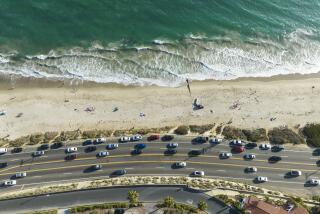Refreshing Opening for Choked Lagoon
- Share via
Joan Jackson waited Wednesday to hear her favorite sound--pebbles clacking against each other as water flows over them through a channel between Los Penasquitos Lagoon and the sea.
Jackson, chairwoman of Los Penasquitos Lagoon Foundation, watched as a tractor dredged the mouth of the 385-acre lagoon Wednesday, which was clogged with sand by recent storms. The tractor dug a 6-foot-deep channel starting on the seashore and reached the edge of the lagoon about 2 p.m., sending stagnant water rushing toward the ocean.
Fresh seawater flows back into the lagoon during high tides, clicking the pebbles against each other.
The lack of flow had caused oxygen levels in the lagoon water to drop dramatically in the past two weeks, which “could lead to a big fish kill,” said biologist John Boland, referring to a phenomenon in which fish suffocate en masse and float to the water’s surface. Boland works with Pacific Estuarine Research Laboratory, a research group of San Diego State University that monitors lagoon water for the foundation.
Los Penasquitos Lagoon is part of Los Penasquitos Marsh Natural Preserve, a 630-acre area west of Interstate 5 near Carmel Valley Road. The lagoon had a coastline that stretched for half a mile before Highway 101 was built, said foundation member Lynn Robinson. The mouth of the lagoon is now about 100 feet wide, the width of the highway bridge overhead.
The lagoon’s narrow mouth is repeatedly clogged by silt from surrounding developments, and by sand and pebbles washed in by storms, Robinson said. The lack of water circulation makes the lagoon susceptible to pollution and causes huge swings in salinity and oxygen content.
The foundation works to protect and maintain the lagoon, and periodically sponsors dredgings of the lagoon mouth. The State Department of Parks and Recreation, which owns most of the lagoon and manages it as part of neighboring Torrey Pines State Reserve, dredged in the spring, Jackson said. The foundation dredged again in the summer, but the mouth became clogged again two months ago. Wednesday’s dredging will cost the foundation $2,500, Robinson said.
Boland said more birds than usual were landing at the lagoon, probably because “the fish are stressed and are coming to the surface for oxygen.”
At least 30 species of birds and a variety of ocean fish, plants and invertebrates such as worms and snails make the lagoon their home, Boland said. The lagoon is one of six coastal wetlands in North County.


